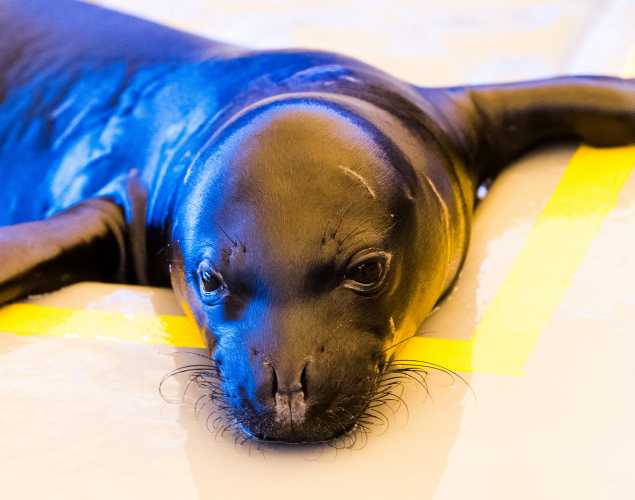
Modeling a Morbillivirus Outbreak in Hawaiian Monk Seals to Aid in the Design of Mitigation Programs
- Infectious disease
- Species conservation
Abstract
We developed a stochastic susceptible–exposed–infectious–removed (SEIR) model to simulate a range of plausible morbillivirus outbreak scenarios in a randomly mixing population of 170 endangered Hawaiian monk seals (Neomonachus schauinslandi). We then modeled realistic vaccination and quarantine measures to determine the potential efficacy of such mitigation efforts. Morbillivirus outbreaks represent substantial risk to monk seals—91% of simulated baseline outbreaks grew (R0>1), and in one-third of the scenarios all, or nearly all, individuals were infected. Simulated vaccination efforts in response to an outbreak were not effective in substantially reducing infections, largely because of the prolonged interval between vaccination and immunity. Prophylactic vaccination, in contrast, could be an effective tool for preventing outbreaks. Herd immunity is practically achievable because of the small sizes of monk seal populations and the animals' accessibility on shore. Adding realistic spatial structure to the model, as informed by movement of seals tracked in the main Hawaiian Islands with the use of telemetry, greatly reduced the simulated impact of outbreaks (≤10 seals were infected in 62% of spatially structured simulations). Although response vaccination remained relatively ineffective, spatial segregation allowed herd immunity to be achieved through prophylactic vaccination with less effort. In a randomly mixing population of 170 seals, 86% would need to be vaccinated to achieve herd immunity in 95% of simulated outbreaks, compared to only approximately 60% in three spatially segregated subgroups with the same combined abundance. Simulations indicate that quarantining a modest number (up to 20) of ill seals has the potential to extinguish even fast-growing outbreaks rapidly. The efficacy of quarantine, however, is highly dependent upon rapid detection and response. We conclude that prophylactic vaccination combined with a quarantine program supported by vigilant surveillance and rapid, reliable diagnosis could greatly mitigate the threat of a morbillivirus outbreak in Hawaiian monk seals.
Baker, J.D., Hartling, A.L., Barbieri, M.M., Robinson, S.J., Gulland, F.M.D., Littnan, C.L. 2017. Modeling a morbillivirus outbreak in Hawaiian monk seals to aid in the design of mitigation programs. Journal of Wildlife Diseases. 53(4).
species conservation
Hawaiian monk seals, morbillivirus, outbreak, vaccination
Related Publications
{"image":"\/Animals\/Wild\/Other species\/nz-sea-lion-shutterstock.jpg","alt":"New Zealand sea lion","title":"Causes of Death in Two Populations of New Zealand Sea Lions","link_url":"https:\/\/www.marinemammalcenter.org\/publications\/causes-of-death-in-two-populations-of-new-zealand-sea-lions","label":"Research Paper"}

{"image":"\/Animals\/Patients\/California sea lions\/csl-by-bill-hunnewell-c-the-marine-mammal-center-6.jpg","alt":"California sea lions","title":"Zoonotic Bacteria Persistence and Susceptibility","link_url":"https:\/\/www.marinemammalcenter.org\/publications\/zoonotic-bacteria-persistence-and-susceptibility","label":"Research Paper"}

{"image":"\/Animals\/Patients\/California sea lions\/cropped-images\/csl-photo-by-bill-hunnewell-c-the-marine-mammal-center-1-0-0-2358-1722-1600891644.jpg","alt":"California sea lions","title":"Emerging Viruses in Marine Mammals","link_url":"https:\/\/www.marinemammalcenter.org\/publications\/emerging-viruses-in-marine-mammals","label":"Research Paper"}

{"image":"\/Animals\/Patients\/California sea lions\/csl-photo-by-bill-hunnewell-c-the-marine-mammal-center-12.jpg","alt":"two California sea lions","title":"Multi-Phase Muscle Breakdown in California Sea Lions","link_url":"https:\/\/www.marinemammalcenter.org\/publications\/multi-phase-muscle-breakdown-in-california-sea-lions","label":"Research Paper"}

Recent News
{"image":"\/Animals\/Patients\/Hawaiian monk seals\/2025\/cropped-images\/d-ru28release-exam-at-ke-kai-ola111025photo-by-giancarlo-rulli-c-the-marine-mammal-center-noaa-permit-24359-0-0-1270-992-1764620886.jpg","alt":"","title":"Bird Flu Vaccine Trial Offers Hope for Protecting Hawaiian Monk Seals","link_url":"https:\/\/www.marinemammalcenter.org\/news\/bird-flu-vaccine-trial-may-offer-hope-for-protecting-hawaiian-monk-seals","label":"News Update","date":"2025-12-01 08:13:00"}

Bird Flu Vaccine Trial Offers Hope for Protecting Hawaiian Monk Seals
December 1, 2025
Read More{"image":"\/Animals\/Patients\/Hawaiian monk seals\/2021\/hms-pp08-by-sheila-latta-c-the-marine-mammal-center-noaa-permit-18786.jpg","alt":"Hawaiian monk seal","title":"The New York Times: Inside the Bird-Flu Vaccine Trial for Monk Seals","link_url":"https:\/\/www.marinemammalcenter.org\/news\/the-new-york-times-inside-the-bird-flu-vaccine-trial-for-monk-seals","label":"In the News","date":"2025-12-01 01:00:00"}

The New York Times: Inside the Bird-Flu Vaccine Trial for Monk Seals
December 1, 2025
Read More{"image":"\/Animals\/Wild\/Sea otter\/so-wild-morro-bayphoto-c-brian-simuro-20.jpeg","alt":"Sea otter and pup","title":"Watch a Sea Otter Pup Reunite With Its Mother","link_url":"https:\/\/www.marinemammalcenter.org\/news\/watch-sea-otter-pup-reunite-with-its-mother","label":"News Update","date":"2025-11-14 10:35:41"}

{"image":"\/Animals\/Wild\/Sea otter\/sea-otter-photo-c-brian-simuro.jpeg","alt":"Sea otter","title":"AP News: Baby sea otter is reunited with mother in central California after dramatic rescue","link_url":"https:\/\/www.marinemammalcenter.org\/news\/ap-news-baby-sea-otter-is-reunited-with-mother-in-central-california-after-dramatic-rescue","label":"In the News","date":"2025-11-14 09:46:34"}

AP News: Baby sea otter is reunited with mother in central California after dramatic rescue
November 14, 2025
Read More